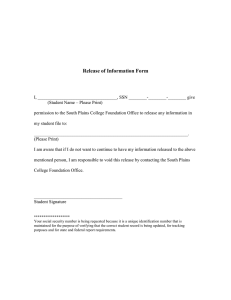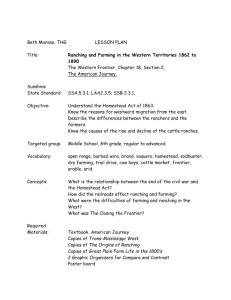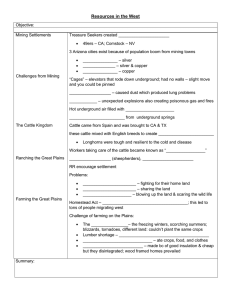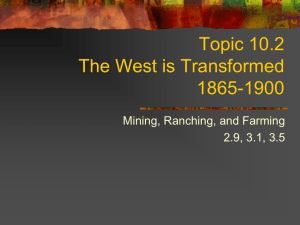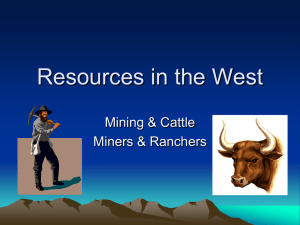I. Growth of the Mining Industry (pages 237–238) A.
advertisement
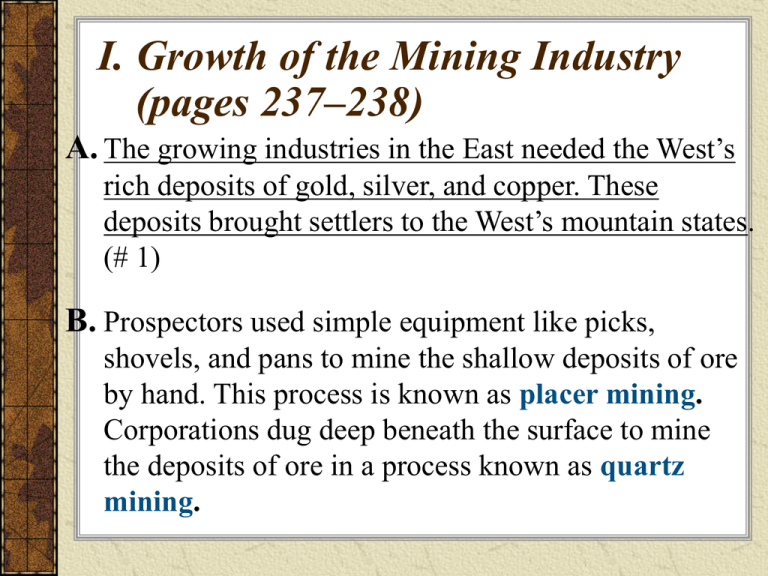
I. Growth of the Mining Industry (pages 237–238) A. The growing industries in the East needed the West’s rich deposits of gold, silver, and copper. These deposits brought settlers to the West’s mountain states. (# 1) B. Prospectors used simple equipment like picks, shovels, and pans to mine the shallow deposits of ore by hand. This process is known as placer mining. Corporations dug deep beneath the surface to mine the deposits of ore in a process known as quartz mining. I. Growth of the Mining Industry (pages 237–238) C. In 1859 prospector Henry Comstock staked a claim for a silver mine in Six-Mile Canyon, Nevada. This caused Virginia City, Nevada, to go from an outpost to a boomtown almost overnight. (# 2). Several years later, the mines ran out of silver and the boomtown became a ghost town. The cycle of boom and bust was repeated throughout the mountainous West. (# 3) I. Growth of the Mining Industry (pages 237–238) E. Mining helped the growth of Colorado, the Dakota Territory, and Montana. Mining in Colorado spurred the building of railroads through the Rocky Mountains (#4). Denver became the supply point for the mining areas and the second largest city in the West after San Francisco. Reading Check p. 238 How did the discovery of new mines affect settlement in the West? It brought tons of new settlers to the West and created boomtowns over night. II. Ranching and Farming the Plains A. The Great Plains region extends westward to the Rocky Mountains from around the 100th meridian—an imaginary line running north and south from the central Dakotas through western Texas. II. Ranching and Farming the Plains B. After the Civil War, many Americans began building large cattle ranches on the Great Plains (#5). The Texas longhorn was a breed of cattle that could survive the harsh climate of the plains. They didn’t require as much water and were able to survive on the tough pairie grass. (#6) II. Ranching and Farming the Plains C. The cattle ranching industry grew in part because of the open range—vast areas of grasslands owned by the federal government. Cattle raisers could graze their herds free of charge and without boundaries. D. During the Civil War, large numbers of eastern cattle were slaughtered to feed the Union and Confederate armies. After the war, beef prices soared. This made it worthwhile to round up the longhorns. (#7) II. Ranching and Farming the Plains E. The first long drive in 1866 across the Great Plains to the railroad in Sedalia, Missouri, proved that cattle could be driven north to the rail lines and sold for 10 times the price they could get in Texas. F. Railroads provided easy access to the Great Plains. Railroad companies sold land along the rail lines at low prices and provided credit. II. Ranching and Farming the Plains G. The federal government helped settle the Great Plains by passing the Homestead Act in 1862. For $10, a settler could file for a homestead, or a tract of public land available for settlement. The homesteader could get up to 160 acres of public land and could receive title of it after living there five years. This provided a legal method for settlers to acquire clear title to property in the west. (#9) II. Ranching and Farming the Plains H. Settlers on the Plains found life very difficult. The environment was harsh, with summer temperatures soaring over 100°F and winter bringing blizzards and extreme cold. Rainfall averaged less than 20” per year, trees only grew naturally along rivers and streams. (#8) Prairie fires and swarms of grasshoppers were a danger and a threat. II. Ranching and Farming the Plains I. By the 1860s, farmers on the Great Plains were using newly designed steel plows, seed drills, reapers, and threshing machines. These machines made dry farming possible. Farmers could work large tracts of land with the machines. II. Ranching and Farming the Plains J. Wheat withstood drought better than other crops, so it became the most important crop on the Great Plains. Wheat farmers from Minnesota and other Midwestern states moved to the Great Plains in large numbers to take advantage of the inexpensive land and the new farming technology. The Wheat Belt began at the eastern edge of the Great Plains and included much of the Dakotas and the western parts of Nebraska and Kansas. (#10). II. Ranching and Farming the Plains K. Several events caused Great Plains farmers to fall on hard times. In the 1890s, a glut of wheat caused prices to drop. Some farmers lost their land because they could not repay bank loans they had taken out. A prolonged drought that began in the 1880s forced many farmers to return to the East. Reading Check p. 240 Why did the Homestead Act motivate settlers to move to the Great Plains? The Homestead Act secured individual property rights to settlers, which made people more willing to move there. III. Native Americans A. Some Native American nations of the Great Plains lived in communities and farmed and hunted. Most Native Americans of the Great Plains were nomads who moved from place to place in search of food. They followed the herds of buffalo. B. Native American groups of the Great Plains had several things in common. They lived in extended family networks and had a close relationship with nature. They were divided into bands with a governing council. Most Native American groups practiced a religion based on a belief in the spiritual power of the natural world. III. Native Americans C. Native Americans had been under pressure for years from advancing white settlement. In 1862 the Sioux in Minnesota launched a major uprising. Native Americans were deprived of hunting grounds, treaties guaranteeing them certain lands were broken and they were forced to relocate (#11). D. In 1867 Congress formed an Indian Peace Commission, which proposed creating two large reservations on the Plains. The Bureau of Indian Affairs would run the reservations. The U.S. army would deal with any groups that did not report to or remain on the reservations. (#12) III. Native Americans E. This plan was doomed to failure. Signing treaties did not ensure that the government or Native Americans would abide by their terms. On the reservations Native Americans faced poverty, despair and the corrupt practices of white traders. (#13) III. Native Americans I. Some Americans had opposed the treatment of Native Americans. Some people thought that the situation between whites and Native Americans could be improved if Native Americans could assimilate, or be absorbed into American society as landowners and citizens. This included breaking up reservations into individual allotments, where Native Americans would live in families and support themselves through farming. The land that remained after all received an allotment would be sold to white settlers with the proceeds going into trust for the Native Americans. (#14). This became the policy when Congress passed the Dawes Act in 1887. III. Native Americans J. The Dawes Act was a failure. Few Native Americans had the training or enthusiasm for farming or ranching. They found the allotments too small to be profitable. Few Native Americans were willing or able to adopt the American settlers’ lifestyles in place of their own culture. Reading Check p. 242 What impact did Helen Hunt Jackson’s book A Century of Dishonor have? Her book sparked discussions of better treatment for Native Americans.
